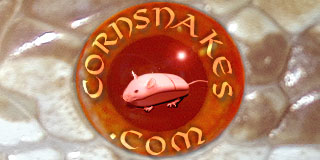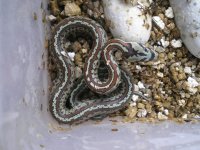More of the Tessera History . .
Okay, here’s a little more on the history of the Tesseras; partially what Graham and KJ told me, and from my experiences with them since receiving one male from Graham.
In 2007, KJ saw a trio of what were advertised to be striped Okeetees – for sale on one of the Online classified sites. Graham bought them, and had them shipped to KJ, since Graham works long shifts, and it was smarter to have them sent to his friend, KJ. When KJ got them, they amounted to a reverse trio (2.1) instead of the advertised trio. They discussed it, and to my surprise, Graham offered me the extra male. I initially said that since it was virtually impossible to make striped Okeetees (the motley/stripe mutation essentially eliminates virtually all black), I was not interested. When KJ told me they were beautiful, and indeed possessed black bordering the dorsal striping, but that they did not appear to be striped (they looked more like striped motley), I said I’d love to have the extra male. KJ
or Graham quizzed the breeder who said that the sire and dam (or was it grandsire and granddam?) comprised a stripe and Okeetee. He even provided photographs of those progenitors. We were puzzled that striped motlies would be the target genetic products, since they should have been classically striped instead. KJ emailed pix of the progenitors to me, and indeed the pix showed a classically striped corn and an Okeetee. Further, the breeder contacted Graham and/or KJ to say that one more sibling of this reverse trio was given by him, to a friend. That friend later wrote to Graham and/or KJ to verify that he indeed still had one. Hence, it is possible that one of those two people will see this thread, and chime in. KJ is very busy moving now, but Graham may also be able to elaborate on this part of the Tessera history.
In 2008, I bred that male to a common-looking corn that is het for stripe and amel. Half the resulting brood was very much like the sire (
essentially the best striped motley look you can imagine). What was most puzzling was the fact that there was so little general distinction between those siblings. Further, anyone who has seen lots of striped motlies will attest to the common characteristic of this compound mutation being the pronounced discontiguous and erratic (if not sometimes chaotic) striping. I did not suspect any surprise genetic discoveries, since progeny of striped motley paired with striped corns (or het stripe – in this case) often results in striped motlies (AND STRIPES). Yes, there were classically striped corns in this brood also. In addition to the classic Okeetee-looking corns and Tesseras were classically striped corns, classically striped motlies, and motley corns (the latter three lacked the lateral tessellation, one of the most obvious features of Tesseras). Again, nothing in that brood to suggest anything new. I reported the results to Graham and KJ, and except for the relatively perfect striping on the classically striped ones, the classic striped motlies, AND what we later determined were the Tesseras; nothing seemed unusual. Nothing, that is, until the next two groups of 2008 babies hatched.
When I started the 2008 breeding season, I decided that if we could increase the width of the black that bounded the dorsal ground stripe, we could really WOW cornsnake lovers by not only showing the heretofore rare black striping that has eluded those who sought to produce striped Okeetees, but making it even more pronounced by increasing its width. Therefore, in addition to breeding the male from Graham to that het striped female, I bred him to two F2 Okeetees from Chip Bridges’ famous Rhett Butler line. I must admit that using those two females turned out to be a co-incidental and beneficial decision. I chose those sisters for their thick black borders, since I had hand-picked them for that trait, from a batch of babies I produced from Chip’s breeders (here on breeder loan). I knew Chip had worked hard to keep animals of that line purely Okeetee locality corns, but I didn’t know that fact would support the observation that the mode of inheritance was dominant in genetic nature. Imagine my shock to see that nearly 50% of the progeny from those novel pairings were Tesseras. I contacted KJ about it - to see if they had similar results, but last year, they had only produced four non mutants from this line.
I let KJ/Graham name them, since Graham was generous enough to make this possible for me. I bred the male to many novel females this year (both common corn mutations, and nominate forms alike), so in addition to KJ/Graham’s production this year and my production this year (and last), we now know Tessera is a dominate mutations. Last year, all I could do to demonstrate those two females were not het for motley/stripe was to cite their originator, Chip Bridges. I personally have had no communication with the original Tessera owner to determine if he had any success, but perhaps KJ and/or Graham have.
So far, there have been enough classically striped, classically striped motley, and classic motlies produced in these pairings, to say there is some relationship between Tessera and the recessive stripe/motley mutation. Each dam that was homozygous OR heterozygous for motley OR stripe, yielded striped mutants, striped motley mutants, motley mutants, and in the cases where the female was HET for striped or motley – non mutants. I’m not making it official yet, but in three such pairings involving striped corns and striped motley corns this year, no non mutant corns were produced, demonstrating a relationship between Tessera and the recessively inherited mutations, motley and stripe. What’s remarkable is the quality of the motley, striped motley, and striped corn siblings of the Tesseras. In 2010, I will perform breeding trials with some of those 2008 striped and striped motley non Tessera-looking corns that lack lateral tessellation, and will share the results via my web site and Online cornsnake chat forums. I promise to post pix of the 2008s and the 2009s so far. I’m seeing exactly the same results this year, that I got last year.
BTW, I was personally not insulted by Slang’s questioning. We’d have to be blind not to notice the similarities of this mutation to the striped mutation in some old world(and new world) rat snakes. We’d also have to be blind not to see this look in other species. I’m certain that ALL mutations we see in rat snakes (and other snake species) will eventually be seen in virtually ALL snake species. Garters are the most obvious look-alikes on our continent, but to presume corns borrowed this mutation from another species would require us to say that striped corns are products of garter and ribbon snake hybrids. Of course it would follow that white-sided blood pythons may be the result of hybridizion with white-sided bull or rat snake mutants; and so on. No way! Mutations are usually mistakes in the copying of genetic material during cell division (
http://en.wikipedia.org/wiki/Mutation), so I believe that it is even possible that nominate patterns and colors in snakes today owe their successful natural appearance to early DNA boo boos. Hence, there’s nothing wrong with questioning the origins of a new snake morph, given the corrupt nature of unscrupulous breeders that endeavor to hybridize popular animals to enhance their value. I personally have never owned any of the European rat snakes mentioned in this thread (
I have not fully scrutinized all posts within), but I think if there is a relationship between Tessera corns and any other species, it’s purely co-incidental, citing the reasons why there are so many parallel appearances between species in nature. Does it follow that similar species are the result of hybridizing (naturally or otherwise)? Not always!
Don


